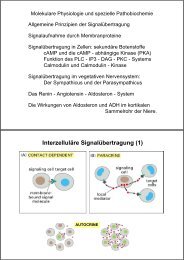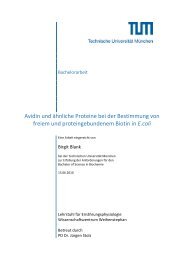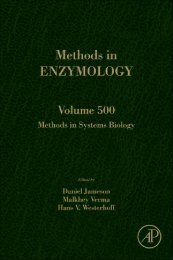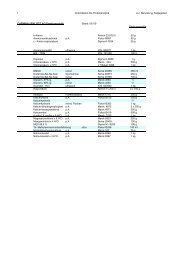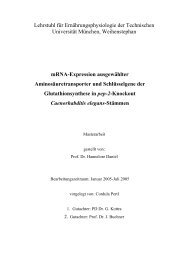Review The role of insulin and IGF-1 signaling in longevity
Review The role of insulin and IGF-1 signaling in longevity
Review The role of insulin and IGF-1 signaling in longevity
Create successful ePaper yourself
Turn your PDF publications into a flip-book with our unique Google optimized e-Paper software.
CMLS, Cell. Mol. Life Sci. Vol. 62, 2005 <strong>Review</strong> Article 321<br />
medic<strong>in</strong>es <strong>and</strong> relatively abundant food, the average lifespan<br />
<strong>in</strong> many developed countries is 80 or more years [3,<br />
4]. With this <strong>in</strong>crease <strong>in</strong> lifespan, causes <strong>of</strong> death have<br />
also changed, with <strong>in</strong>fectious diseases <strong>and</strong> trauma be<strong>in</strong>g<br />
replaced by cardiovascular disease, cancer, diabetes mellitus<br />
<strong>and</strong> diseases <strong>of</strong> the elderly such as Park<strong>in</strong>son’s <strong>and</strong><br />
Alzheimer’s diseases. Interest<strong>in</strong>gly, it appears that maximum<br />
lifespan (<strong>longevity</strong>) has not changed dramatically<br />
<strong>and</strong> seems to rest at about 120 years [5]. Thus, although<br />
the number <strong>of</strong> centenarians has <strong>in</strong>creased, maximum human<br />
lifespan has not.<br />
<strong>The</strong>ories <strong>of</strong> ag<strong>in</strong>g<br />
<strong>The</strong>re are several theories <strong>of</strong> ag<strong>in</strong>g [6] that po<strong>in</strong>t to four<br />
broad physiological processes important for <strong>longevity</strong>:<br />
genetic stability, telomere shorten<strong>in</strong>g, stress resistance<br />
<strong>and</strong> metabolic control.<br />
Genetic stability: accumulation <strong>of</strong> genetic errors<br />
One <strong>of</strong> the classic theories <strong>of</strong> ag<strong>in</strong>g is based on the <strong>role</strong> <strong>of</strong><br />
accumulation <strong>of</strong> genetic errors. It has been recognized for<br />
many years that ioniz<strong>in</strong>g radiation causes DNA damage<br />
that can lead to early ag<strong>in</strong>g <strong>in</strong> mice [7–9]. Conversely, resistance<br />
to ultraviolet radiation is associated with <strong>in</strong>creased<br />
lifespan <strong>in</strong> yeast [10]. Somatic mutations <strong>and</strong><br />
chromosomal abnormalities, such as translocations <strong>and</strong><br />
aneuploidy, are <strong>in</strong>creased <strong>in</strong> cells isolated from old <strong>in</strong>dividuals<br />
compared to young <strong>in</strong>dividuals, presumably as a<br />
result <strong>of</strong> such DNA damage [11, 12].<br />
In addition, dysregulation <strong>of</strong> DNA repair, cell cycle <strong>and</strong><br />
<strong>in</strong>tegrity <strong>of</strong> extracellular matrix are found <strong>in</strong> cells isolated<br />
from old people <strong>and</strong> <strong>in</strong>dividuals with some premature ag<strong>in</strong>g<br />
syndromes [13–16]. Patients with Werner’s syndrome<br />
who have mutations <strong>in</strong> the WRN gene, which encodes<br />
a helicase needed for DNA repair, show early signs<br />
<strong>of</strong> ag<strong>in</strong>g <strong>and</strong> have decreased lifespan [17, 18]. Patients<br />
with Cockayne syndrome have mutations <strong>in</strong> genes responsible<br />
for DNA repair <strong>and</strong> reduced lifespan [19]. Patients<br />
with ataxia telangiectasia who lack the ATM gene,<br />
a gene product required for detect<strong>in</strong>g DNA damage <strong>and</strong><br />
<strong>in</strong>itiat<strong>in</strong>g repair response, also die young [20]. ATM k<strong>in</strong>ase<br />
is activated by <strong><strong>in</strong>sul<strong>in</strong></strong> <strong>and</strong> has a wide <strong>role</strong> <strong>in</strong> signal<br />
transduction <strong>and</strong> cell growth as well as <strong>in</strong> sens<strong>in</strong>g redox<br />
homeostasis [21]. Thus, <strong>in</strong>dividuals with ATM mutations<br />
are also predisposed to cancer [22]. Children with<br />
Hutch<strong>in</strong>son-Gilford progeria syndrome show signs <strong>of</strong> ag<strong>in</strong>g<br />
very early <strong>and</strong> <strong>of</strong>ten die <strong>in</strong> their teens [23]. This disease<br />
is caused by mutations <strong>in</strong> the gene for lam<strong>in</strong><br />
(LMNA). Although not proven to be directly <strong>in</strong>volved <strong>in</strong><br />
genetic stability, this is an <strong>in</strong>termediate filament prote<strong>in</strong><br />
that stabilizes the <strong>in</strong>ner membrane <strong>of</strong> the nuclear envelope<br />
[24, 25]. Interest<strong>in</strong>gly, mutations <strong>in</strong> this same gene<br />
are also associated with lipoatrophic diabetes [26–30].<br />
DNA repair rates appear to correlate positively with lifespan<br />
among mammals. Furthermore, the DNA repair rate<br />
positively correlates with body size, which itself correlates<br />
with lifespan [31]. Accumulation <strong>of</strong> genetic errors<br />
also causes cancer, so it is not surpris<strong>in</strong>g that <strong>in</strong>cidence <strong>of</strong><br />
cancer <strong>in</strong>creases with age.<br />
In addition to mutations <strong>of</strong> nuclear DNA, po<strong>in</strong>t mutations<br />
<strong>and</strong> deletions <strong>of</strong> mitochondrial DNA (mtDNA) accumulate<br />
<strong>in</strong> a variety <strong>of</strong> tissues dur<strong>in</strong>g ag<strong>in</strong>g <strong>in</strong> humans [32],<br />
monkeys [33] <strong>and</strong> rodents [34]. <strong>The</strong>y cause a mosaic pattern<br />
<strong>of</strong> respiratory cha<strong>in</strong> deficiency <strong>in</strong> tissues such as<br />
heart [35], skeletal muscle [36] <strong>and</strong> bra<strong>in</strong> [37]. Mice that<br />
express a pro<strong>of</strong>read<strong>in</strong>g-deficient version <strong>of</strong> the nucleusencoded<br />
catalytic subunit <strong>of</strong> mtDNA polymerase develop<br />
mtDNA mutator phenotype with an <strong>in</strong>creased level <strong>of</strong><br />
po<strong>in</strong>t mutations <strong>and</strong> deletions [38]. This is associated<br />
with reduced lifespan <strong>and</strong> premature onset <strong>of</strong> ag<strong>in</strong>g-related<br />
phenotypes, such as weight loss, reduced subcutaneous<br />
fat, alopecia (hair loss), kyphosis (curvature <strong>of</strong> the<br />
sp<strong>in</strong>e), osteoporosis, anaemia, reduced fertility <strong>and</strong> heart<br />
enlargement [38]. This provides a causative l<strong>in</strong>k between<br />
mtDNA mutations <strong>and</strong> ag<strong>in</strong>g phenotypes <strong>in</strong> mammals.<br />
Telomere shorten<strong>in</strong>g: a ‘biological clock’<br />
Telomeres are the term<strong>in</strong>i <strong>of</strong> l<strong>in</strong>ear eukaryotic chromosomes.<br />
<strong>The</strong>y are <strong>in</strong>volved <strong>in</strong> stabiliz<strong>in</strong>g the <strong>in</strong>tegrity <strong>of</strong><br />
the ends <strong>of</strong> chromosomes [39], <strong>in</strong>hibit<strong>in</strong>g the aberrant fusions<br />
<strong>and</strong> rearrangements that occur on broken chromosomes,<br />
<strong>and</strong> aid<strong>in</strong>g the completion <strong>of</strong> duplication. Dur<strong>in</strong>g<br />
each cell cycle telomeric repeats (TTAGGG) are lost because<br />
DNA polymerase is unable to replicate the 3¢ end <strong>of</strong><br />
l<strong>in</strong>ear DNA completely, leav<strong>in</strong>g a G-str<strong>and</strong> overhang. In<br />
germ cells <strong>and</strong> carc<strong>in</strong>omas, telomeric repeats are ma<strong>in</strong>ta<strong>in</strong>ed<br />
by ribonucleoprote<strong>in</strong> telomerase that is capable <strong>of</strong><br />
elongat<strong>in</strong>g telomeres de novo [40]. However, <strong>in</strong> the absence<br />
<strong>of</strong> telomerase activity, telomeres shorten with each<br />
cell division, reflect<strong>in</strong>g the age <strong>of</strong> the cell l<strong>in</strong>eage<br />
[41–43]. Many studies <strong>in</strong> a variety <strong>of</strong> tissues from mammals<br />
<strong>and</strong> other vertebrates have shown a gradual decrease<br />
<strong>of</strong> telomere length with age [43–46] <strong>and</strong> with doubl<strong>in</strong>g<br />
time <strong>in</strong> cell culture [41]. In addition, a positive correlation<br />
between telomere shorten<strong>in</strong>g <strong>and</strong> maximum lifespan has<br />
been shown <strong>in</strong> birds <strong>and</strong> mammals [47–49], suggest<strong>in</strong>g<br />
that regulation <strong>of</strong> telomere length is not only associated<br />
with cellular replicative lifespan, but also with lifespan <strong>of</strong><br />
the whole organism.<br />
Genome size (DNA quantity per cell) is also positively<br />
correlated with <strong>longevity</strong> <strong>in</strong> birds [50] <strong>and</strong> <strong>in</strong> fishes [51].<br />
However, how genome size can affect an organism’s phenotype<br />
<strong>and</strong> <strong>longevity</strong> rema<strong>in</strong>s unclear.<br />
In yeast, one <strong>of</strong> the manifestations <strong>of</strong> ag<strong>in</strong>g is a loss <strong>of</strong><br />
transcriptional silenc<strong>in</strong>g <strong>of</strong> genes located <strong>in</strong> the heterochromatic<br />
region near telomeres <strong>and</strong> at the silent mat-



